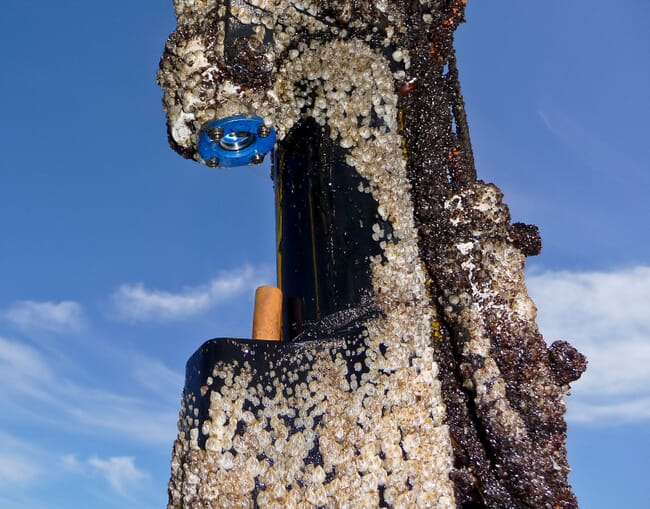
© Mariscope Meerestechnik
Biofouling, the accumulation of unwanted material on solid surfaces under water, can lead to the detriment of function, impeding or even interfering with aquaculture operations. For example, biofouling on nets is known to reduce oxygenation levels in pens, while even thin biofilms of algae can provoke misleading results by measuring equipment.
Relating to the latter, the Leibniz Institute for Baltic Sea Research Warnemünde (IOW) has developed a new antifouling UV spotlight. Now, after three years of development, this non-toxic antifouling alternative has been licensed for commercial production to Mariscope Meerestechnik. The new system for the first time uses lens optics to focus the UV light of energy-efficient LEDs and thus keeps irradiated surfaces permanently free of organic deposits.
It was originally intended for continuous deployment on three autonomous measuring stations belonging to the Marine Environmental Monitoring Network in the North Sea and Baltic (MARNET) on behalf of the Federal Maritime and Hydrographic Agency (BSH). MARNET’s underwater sensors continuously register temperature, salt and oxygen content, sea currents and the development of phytoplankton by means of chlorophyll a fluorescence measurement.
Background
Robert Mars is an IOW instrumentation expert and the inventor of this new antifouling UV spotlight. He explains that organisms that colonise probes have a considerable effect on the sensory equipment – for example, by hindering the oncoming flow of water, altering the measuring environment in the close vicinity of the probes, weakening their sensitivity and much more.
“For example, without antifouling, it takes only two to four weeks – depending on the season – until algae growth massively falsifies the measurement of chlorophyll a fluorescence,” he said.
Walter Scheel, marketing coordinator at Mariscope Chile, adds: “Since the instruments are increasingly precise and resistant, this antifouling system helps to reduce the bias of the data and costs of maintenance, providing reliable measurements for longer periods.”
Moreover, he says that this device has high efficiency in fouling control and energy consumption, which would allow it to operate on a battery basis for long periods without interruptions.
Let there be light
This antifouling spotlight is a handy tool, with a robust titanium casing and a 3D-printed plastic mount. Quartz-glass lenses focus the UV light to counteract underwater light-scattering and efficiently direct the radiation exactly to the area where it is needed. With a wavelength of 200-280 nanometres, UV-C light has been chosen as the type of ultraviolet radiation for this device. “This has already been used for disinfection for quite some time – also underwater. But only in recent years, high-performance UV-C light-emitting diodes (LEDs) have been available that, compared to the traditional UV mercury vapour lamps, have exactly the properties we need,” Mars says.
Scheel adds that, due to the frequency of UV light, it has a much higher penetration rate than conventional light.
“Since the system is primarily intended to reduce biofouling in sensors, as well as in oceanographic instruments (eg current profilers), the area to be covered can be quite different, depending on the set of lenses used to project the light beam,” he explains.
He adds that UV-C rays could not be used in photoperiod lamps, for example, given that they could cause damage to fish and other fauna. “However, they could be used in water-intake entrances, or underwater pipes with a high rate of fouling proliferation,” he says.

© Mariscope Meerestechnik
Trials
The device has already been successfully used at all three MARNET stations since June 2019. “It has passed the intensive testing with distinction. All target areas could be kept completely and permanently free of fouling by irradiation from a distance of up to 1m. The UV exposed sensors, in particular the interference-prone chlorophyll fluorometer, now consistently deliver very good data and the casing successfully defies the harsh field conditions in the middle of the Baltic Sea,” says Mars.
These tests verified the effectiveness of the UV light source system in areas of high biofouling contamination, allowing the sensor areas to be kept free of elements that generated a deterioration of the data “by keeping the areas free of biological contamination, such as algae and mollusc larvae, among others”, says Scheel.
“It should be noted that the oceanographic instruments begin to present [evidence of] fouling shortly after contact with the water (15-90 minutes). It starts as bacteria colonies on the surfaces, causing the data to dgegrade, which is corrected by mathematical models, to reduce the biases of the data associated with fouling,” he adds.
Scheel points out that this device needs to be installed simultaneously with the measuring instrument, to obtain data without degredation from the beginning. It should be noted that the antifouling UV spotlight requires a specific area to be targeted, since the light does not have even an indirect effect on the surrounding areas,. The installation of this device would be recommended in new deployments of measuring instruments, or in recently cleaned ducts, to result in a surface that is as free as possible of unwanted organic elements.
Market
A patent is currently pending for the spotlight, with its innovative first-time use of the lens optics – which are key to its powerful antifouling effect.
“The lenses make our system 100 times more efficient than the only commercial product so far available on the market with comparable applications,” says Mars.
The IOW engineer assumes that there is a great demand for such an antifouling device, especially in marine research. “But one can also imagine many other areas of application – for example in aquaculture, where the long-term use of underwater sensor technology also plays a major role,” Mars concludes.
In order to make the IOW’s antifouling UV spotlight accessible to a wide range of users, it was been licensed for serial production by Mariscope Meerestechnik in February 2020. So far, these devices have been making their debut in Chile in port facilities, and in different measurement facilities, either in ADCP (acoustic doppler current profiler) or in CTD (conductivity, pressure and depth) equipment.

